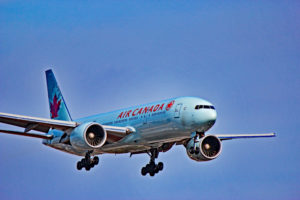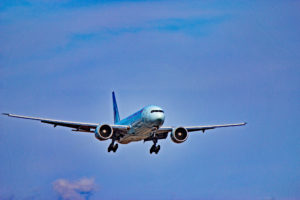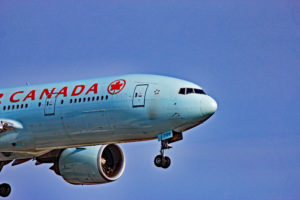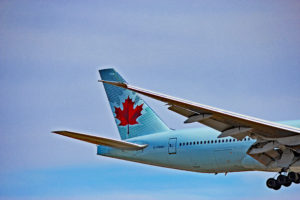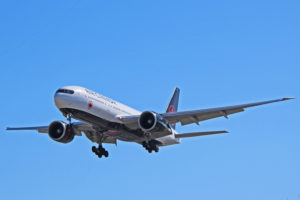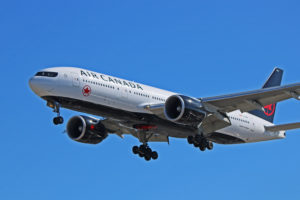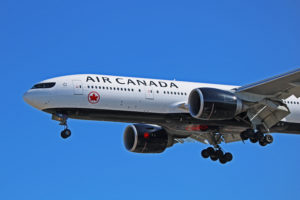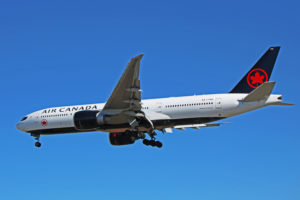Another Update – This was the Air Canada Boeing 777-200LR that was involved in a sudden turbulence incident on July 12, 2019. On a flight from Vancouver, British Columbia to Sydney, Australia, the airplane met up with severe turbulence 600 miles southwest of Hawaii.
As a result, the aircraft was diverted to Honolulu. 37 on board were taken to hospital. Nine of the injuries were considered serious.
* Update April 25, 2018 *
We’ve added a new gallery below with images of C-FNNH sporting the latest Air Canada livery. Those photos were taken at Toronto Pearson on April 20, 2018.
C-FNNH is a Boeing 777-233LR belonging to Air Canada. The airplane has been involved in five notable incidents in its relatively short life since being delivered to Air Canada in 2008. Twice, the inflight entertainment system had to be shut down with an electric burning smell noted in the passenger cabin.
The images in the gallery were taken on March 13, 2012 at Toronto Pearson International Airport (YYZ). For full-size, high resolution versions for any of the photos, simply click on the individual pictures. See below for more information on this specific aircraft and its troubles, along with info on the Boeing 777-200LR model in general and the airline.
Image Gallery
Updated Gallery
C-FNNH
Boeing 777-200LR
Air Canada
Resources
C-FNNH Air Canada Boeing 777-200LR Image Gallery
C-FNNH Updated Gallery With Latest Air Canada Livery
High resolution versions of this type of aircraft and much more are available at Dreamstime. Want to earn cash from your own photos? Why not sign up for free with Dreamstime and start submitting now: Become a paid photographer!
C-FNNH
C-FNNH is a Boeing 777-200LR that made its first flight on February 18, 2008 and was delivered to Air Canada on February 28, 2008. This is one of six 777-200LR models in the Air Canada fleet and is configured with 40 business class seats, along with 24 in premium economy and 236 more in economy class.
As mentioned, incidents abound for this aircraft. On October 2, 2009, C-FNNH was performing a flight from Toronto (YYZ) to Vancouver, British Columbia (YVR) before it would continue on to Sydney, Australia.
Somewhere over Regina, Saskatchewan, there was an electric burning smell in the passenger cabin. Several entertainment screens shut down with loud popping sounds. The entertainment system was shut down and the flight continued without further incident. It was determined that the seat electronic box of the inflight entertainment system was faulty and needed to be replaced.
On January 1, 2012, C-FNNH was performing a flight from Vancouver to Sydney, Australia. Climbing out of Vancouver, the airport informed Air Canada about the possibility of tire damage after a considerable amount of debris was found at the end of the runway. There was no system indication immediately but four hours out of Sydney, there was a low hydraulic fluid caution.
At Sydney, the Boeing 777-200LR landed safely but with emergency services on standby. C-FNNH stopped on the runway, shut down its engines and was towed away. It was determined that the number 4 right hand main wheel’s tire and associated brake hydraulic line was damaged with a small leak.
On March 28, 2013, C-FNNH was making a flight from Vancouver to Toronto. The aircraft landed safely but without receiving a landing clearance from the control tower.
On December 30, 2015, the Boeing 777 was flying from Hong Kong to Toronto and was over Anchorage, Alaska. The airplane experienced prolonged turbulence, at times severe. A flight attendant was injured in the crew rest area due to the turbulence.
On May 6, 2016, C-FNNH was flying from Hong Kong to Toronto. Near Toyko, Japan, the crew decided to divert to Toyko Narita Airport, reporting a smell of smoke in the cockpit. The Boeing 777-200LR landed safely. Once again, the inflight entertainment system was under suspicion.
See more aircraft at our Air Canada Fleet Page.
Access all our featured aircraft at the Airplane Index Page.
Boeing 777-200LR
The Boeing 777-233LR entered service in 2006 as the world’s longest range commercial airliner and still holds the record for the longest nonstop flight. For this reason, Boeing named it the ‘Worldliner’. The LR stands for longer range.
This plane can hold up to 440 passengers in a single class, sardine can configuration. The aircraft is 209 feet long with a wingspan of 213 feet. At the tail, the airplane stands 61 feet tall. This is Air Canada’s second largest airliner, behind the Boeing 777-300ER.
Air Canada
Air Canada was founded in 1937 as Trans-Canada Air Lines and changed to the current name in 1965. The airline has around 175 aircraft in their main fleet with the largest being the Boeing 777-300ER. Its last Boeing 747 was retired in 2004 and its last Airbus A340 was retired in 2008.
The airline travels to 350 destinations (including subsidiaries like Air Canada Express and Air Canada Rouge). Air Canada is headquartered in Montreal at Pierre Elliott Trudeau International Airport (YUL).
Air Canada is a founding member of the Star Alliance, along with Lufthansa, Scandinavian Airlines, Thai Airways and United Airlines. There are currently 27 members in the Star Alliance.
